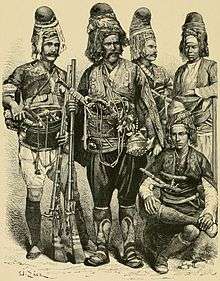Zeybeks

Zeybeks or sometimes Zeibeks, were irregular militia and guerrilla fighters living in the Aegean Region of the Ottoman Empire from late 17th to early 20th centuries.
Before the Treaty of Lausanne and the establishment of the Republic of Turkey, larger concentrations of Zeybeks could be found on the Aegean coast of western Anatolia, near the city of Smyrna. After the Greek invasion of Smyrna they fought against the Greek occupation of western Turkey.[1][2] Following the formation of a Turkish national army, during the Greco-Turkish War of 1919–1922, most of them joined the regular forces and continued their resistance.
They also acted, traditionally, as protectors of village people against landlords, bandits and tax collectors. A leader of a Zeybek gang was called Efe and his soldiers were known as either Zeybeks or Kızan. Kızan was generally used for newly recruited or inexperienced Zeybeks. There was generally a tribe democracy in group. Decisions was taken in a democratic way, after the decision was taken Efe has an uncontroversial authority. They followed definite rituals for all actions; for example, the promotion of a kızan to zeybek was very similar to Ahi rituals.
Zeybeks had a special dance in which performers simulated hawks. Romantic songs about their bravery are still popular in Turkish folk music. The yatagan sword was their primary weapon, but most of them carried firearms as well.
See also
- Efe, the leaders of bands of Zeybeks and Kızan
- Zeibekiko (Greek dance) and Zeybek (Turkish dance)
- Atçalı Kel Mehmet
- Yörük Ali Efe
- Çakırcalı Mehmet Efe
- Hajduk
References
- ↑ Sina Aksin (1 February 2007). Turkey, from Empire to Revolutionary Republic: The Emergence of the Turkish Nation from 1789 to Present. NYU Press. pp. 126–. ISBN 978-0-8147-0722-7.
- ↑ Jeremy Seal (5 July 2012). Meander: East to West along a Turkish River. Random House. pp. 289–. ISBN 978-1-4481-3922-4.
- Publication, "American-Hellenic Society", page 18 (English)
- Onur Akdogu, "Bir Başkaldırı Öyküsü Zeybekler, Cilt 1 - 3 Tarihi - Ezgileri - Dansları" ("A Story of Rebellion - Zeybeks" (3 volumes: History, Music, Dances)), İzmir, Turkey, 2004 (Turkish)
- Views of the "outlaw concept" in comparative perspective: "The American West" and the "Zeybeks" in the Turk lands, H.B. Paksoy